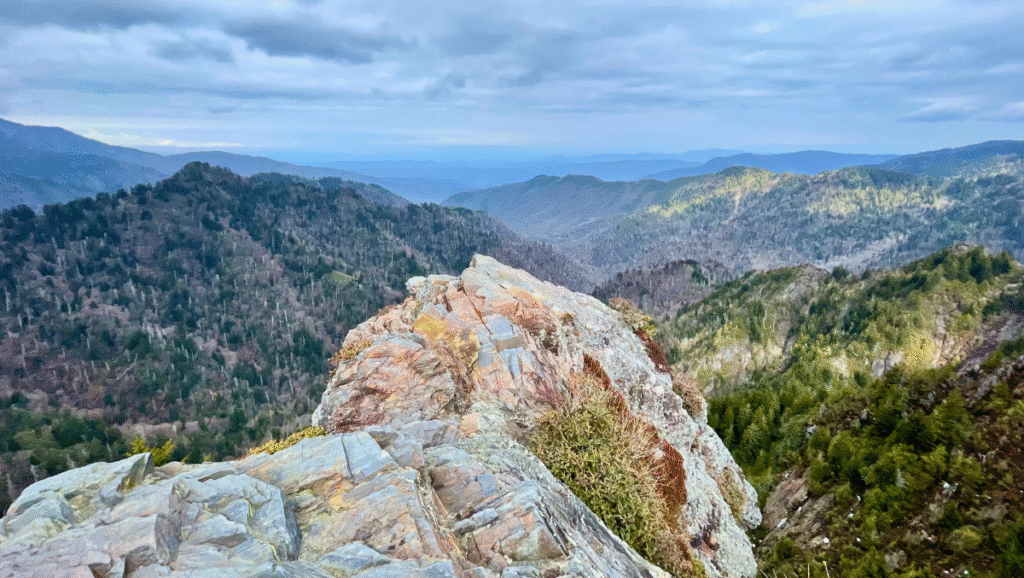The Tale of Charlie Conner and the Smoky Mountains: How Charlies Bunion Got Its Name
As I gaze out over the misty peaks of the Great Smoky Mountains, I’m reminded once again why this place has captured my heart for all these years. The rolling blue ridges, the ancient forests, and the stories—oh, the wonderful stories these mountains hold! Today, I want to share one of my favorite tales from these majestic slopes, a story that explains how one of the park’s most distinctive landmarks got its peculiar name.
A Hiking Adventure That Made History
Gather ’round, friends, and I’ll tell you a tale that’s been passed down through generations of mountain folk. Back in the 1920s, an Appalachian Trail supervisor named Charlie Conner was hiking in the Great Smoky Mountains with his buddy and fellow outdoorsman Horace Kephart. The two men were venturing to a rocky overlook then known as Fodderstack. When they stopped to rest, something unexpected happened that would forever change the map of the Smokies.
As the story goes, Charlie took off his boots and socks to air out his tired feet after the strenuous hike. What his hiking companion saw next was apparently quite memorable—a bunion on Charlie’s foot that resembled the rocky outcrop they were admiring!
The Birth of “Charlies Bunion”
In that moment of levity between friends, Horace Kephart—who would later become instrumental in the creation of Great Smoky Mountains National Park—declared that the rocky outcropping should be named “Charlies Bunion.” The name stuck, and what was once called Fodderstack has been known as Charlies Bunion ever since.
It’s worth noting that this remarkable formation wasn’t always as exposed as it is today. The distinctive bare rock face we see now was largely revealed after devastating fires swept through the area in 1925, followed by heavy rains that washed away the soil, leaving behind the striking geological feature that thousands of hikers visit annually.

Why Charlies Bunion Is Worth the Hike
Having hiked to Charlies Bunion dozens of times in my years of exploring the Smokies, I can tell you it’s absolutely worth the effort. The trail to reach this magnificent overlook is about 4 miles each way from Newfound Gap, following the Appalachian Trail along the spine of the mountains. The views are, in a word, spectacular—offering some of the most breathtaking panoramas in the entire national park.
On clear days, you can see for miles across the undulating landscape of the Smokies, with layer upon layer of mountains fading into the blue distance. It’s no wonder that hikers from around the world make the pilgrimage to this spot, camera in hand, hoping to capture a slice of this natural beauty.
Hiking Tips for Charlies Bunion
- Distance: 8 miles round trip from Newfound Gap
- Difficulty: Moderate to strenuous
- Elevation Gain: Approximately 1,600 feet
- Best Time to Visit: Spring for wildflowers or fall for foliage
- What to Bring: Plenty of water, snacks, camera, and weather-appropriate clothing
I always recommend starting early in the morning to avoid afternoon thunderstorms, which are common in the Smokies, especially during summer months. And please, always practice Leave No Trace principles—this pristine wilderness deserves our respect and protection.
The Legacy of Early Smokies Advocates
The story of Charlies Bunion isn’t just a humorous anecdote—it’s a reminder of the people who helped establish and preserve the Great Smoky Mountains National Park. Horace Kephart, who named the formation, was an author and outdoorsman whose writings helped generate public support for creating the national park. Charlie Conner, meanwhile, worked to develop and maintain the trails that millions enjoy today.
These early advocates understood the importance of preserving these mountains for future generations. Their legacy lives on not just in place names like Charlies Bunion, but in every protected acre of this magnificent wilderness.
Beyond the Bunion: Other Stories in Stone
The Smokies are full of colorfully named landmarks, each with its own story. From Chimney Tops to Clingmans Dome, from Alum Cave to Gregory Bald—these names reflect the rich cultural history of the region, blending Cherokee heritage, settler influence, and the personal stories of those who explored these mountains before they became a national park.
In my years of writing about and exploring the Smokies, I’ve come to appreciate how these names connect us to the past, giving us a sense of the human history that’s as much a part of these mountains as the ancient trees and rushing streams.
Plan Your Visit to Charlies Bunion
If you’re inspired to see Charlies Bunion for yourself (and I hope you are!), plan to set aside a full day for the hike. Park at Newfound Gap, bring plenty of water and snacks, wear sturdy hiking boots, and prepare for changing weather conditions—the mountains create their own weather, and conditions can shift rapidly.
The effort is well worth it, I promise. Standing on that rocky outcrop, feeling the mountain breeze on your face as you gaze out over the vastness of the Smokies—it’s an experience that stays with you long after you’ve returned to the trailhead.
A Mountain Legacy Worth Preserving
Stories like the naming of Charlies Bunion remind us that these mountains are more than just scenery—they’re living landscapes filled with history, culture, and the ongoing relationship between humans and nature. As we hike these trails and admire these views, we’re participating in a tradition that stretches back generations.
So the next time you’re planning a trip to the Great Smoky Mountains, consider adding Charlies Bunion to your itinerary. And as you stand there, taking in that magnificent view, spare a thought for Charlie Conner and his bunion—an unlikely source of inspiration for one of the park’s most beloved landmarks.
The mountains are calling, friends. Will you answer?

